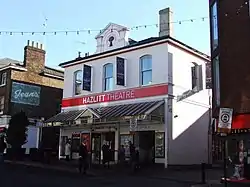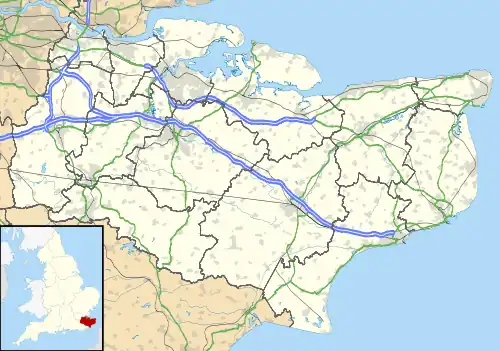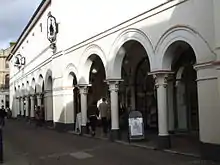Hazlitt Theatre
The Hazlitt Theatre and Exchange Studio, also known as the Hazlitt Arts Centre, is a theatre complex in Earl Street in Maidstone, Kent, England. The oldest part of the complex, which is now used as a shopping complex on the ground floor, and as a theatre venue known as the "Exchange Studio" on the first floor, is a Grade II listed building.[1]
| Hazlitt Theatre and Exchange Studio | |
|---|---|
 Hazlitt Theatre and Exchange Studio | |
| Location | Earl Street, Maidstone |
| Coordinates | 51.2745°N 0.5216°E |
| Built | 1835 |
| Architectural style(s) | Neoclassical style |
| Website | www |
Listed Building – Grade II | |
| Official name | Market Buildings |
| Designated | 2 August 1974 |
| Reference no. | 1086298 |
 Shown in Kent | |
History

The complex was built in two parts. The older part, at the rear of the complex, was commissioned as a corn exchange, sometimes referred to as the "Market Buildings": it was designed by the Kent County Surveyor, John Whichcord Sr.,[2] in the neoclassical style, built with a stucco finish and was completed in 1835. The design involved a long frontage of 18 bays running down the right hand side of the complex. It featured a colonnade in three sections: seven bays in the north section, four bays in the central section and seven bays in the south section. On the ground floor, the bays were separated by Tuscan order columns supporting arches, while, on the first floor, the left hand section was fenestrated by sash windows (two of which were blind), the central section was completely blind, and the right hand section was fenestrated by sash windows (none of which were blind).[1] The architectural historian, Nikolaus Pevsner, was unimpressed with the design and referred to the "ugly mid-19th century arcading".[3]
The newer part, at the front of the complex, was commissioned as a concert hall: it was designed in the neoclassical style, built with a stucco finish, and was completed in 1869. The design involved a main frontage of three bays facing onto Earl Street. On the ground floor, the central bay contained a doorway while, in the right hand bay, there was an opening providing access to the colonnade. On the first floor, there were three segmental headed windows, and at roof level, there was a cornice and a moulded pediment. The pediment contained a circular panel with a carving of a sheaf of corn and the words "The Corn Exchange" around it.[4]
The use of the rear part of the complex as a corn exchange declined significantly in the wake of the Great Depression of British Agriculture in the late 19th century.[5] The ground floor was re-purposed as a series of boutique shops, while the assembly room on the first floor became the "Exchange Studio".[4]
In the context of changing consumer tastes, the concert hall, at the front of the complex, was re-purposed as a theatre in 1955.[6] It was initially known as the "Maidstone Municipal Theatre" and a local theatre group known as the "County Towners Variety Club" performed two variety shows a year.[7][8] By the mid-1980s, it had been re-named after the essayist, William Hazlitt, who had been born in Maidstone in 1778.[9][10] In 1991, Maidstone Borough Council, which holds the freehold on the complex, sold a 125 lease to a property company. It then rented the complex back on a short-term sublease.[11] In 2009, Carolyn Williams unveiled a plaque at the theatre to commemorate the life of her father, the children's television presenter, Tony Hart, who was born in the town.[12]
Facilities
The Hazlitt Theatre offers seating for 382 people while the Exchange Studio offers seating for 200 people. The two venues taken together are known as the "Hazlitt Arts Centre".[4] The venue continues to put on pantomime and other theatrical performances each year.[13]
See also
References
- Historic England. "Market Buildings (1086298)". National Heritage List for England. Retrieved 23 April 2023.
- Colvin, H. A. (1995). Biographical Dictionary of British Architects 1600-1840. London: Yale University Press. p. 1041. ISBN 978-0871964427.
- Pevsner, Nikolaus (1969). West Kent and The Weald. Penguin Books. p. 393.
- "The Hazlitt Theatre and Exchange Studio, Earle Street, Maidstone, Kent". Arthur Lloyd. Retrieved 23 April 2023.
- Fletcher, T. W. (1973). 'The Great Depression of English Agriculture 1873-1896' in British Agriculture 1875-1914. London: Methuen. p. 31. ISBN 978-1136581182.
- Lambert, Tim. "A Brief history of Maidstone". Local Histories website. Retrieved 23 April 2023.
- "Remembering the County Towners at The Hazlitt Theatre in Maidstone". Kent Online. 28 January 2021. Retrieved 23 April 2023.
- "Victor Young recalls the County Towners shows at the Hazlitt Theatre in Maidstone". Kent Online. 26 April 2021. Retrieved 23 April 2023.
- "The life of the controversial writer William Hazlitt". Great British Life. 12 April 2023. Retrieved 23 April 2023.
- Spence, Keith (1999). The Companion Guide to Kent and Sussex. Companion Guides. p. 167. ISBN 978-1900639262.
- "Hazlitt Theatre to continue in hands of Parkwood Leisure, Maidstone council decides". Kent Online. 16 January 2021. Retrieved 23 April 2023.
- "Memorial unveiled for TV artist". BBC News. 31 May 2009. Retrieved 23 April 2023.
- "Hazlitt Theatre Sleeping Beauty Panto Press Launch". Maidstone Borough Council. 14 October 2022. Retrieved 23 April 2023.